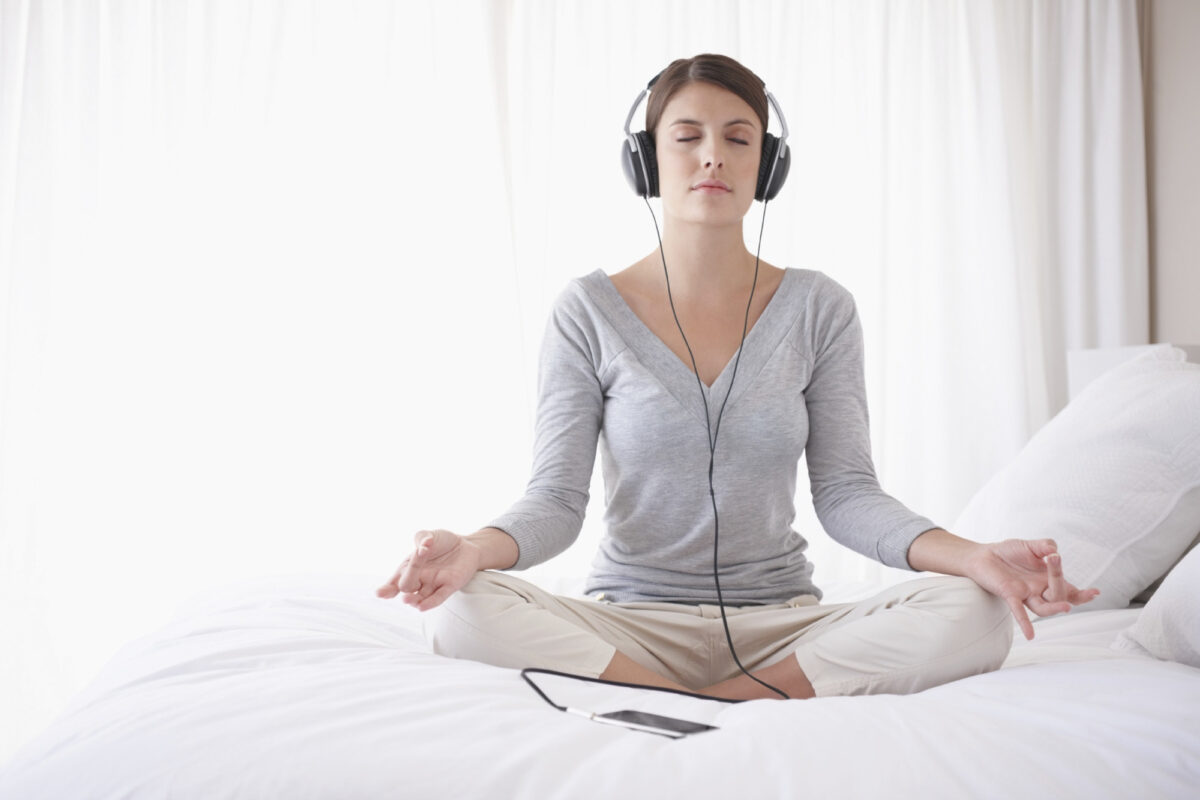

This article is brought to you by Christopher Lloyd Clarke B.Sc, D.Msc. Composer & Director of Enlightened Audio
Most of our Royalty Free brainwave entrainment music uses an audio technology known as “binaural beats”. These binaural beats are embedded in the music in order to bring about desirable changes in brainwave activity, thereby encouraging various states of relaxation, deep meditation or sleep. When played with headphones, you may be able to hear the binaural beats as a subtle pulsing sound beneath the music.
Binaural Beats or “binaural tones” are created by playing slightly different frequencies separately into each ear. The difference between the two frequencies stimulates a response in the brain, which correlates with this frequency difference. For example, if we present a 100 Hz tone to the left ear and a 105 Hz tone to the right ear, a frequency of 5 Hz is stimulated. This is what is known as the “frequency following response”.
While binaural beats are the most common technique we use for producing brainwave entrainment music, we do use other brainwave entrainment techniques such as isochronic tones, monaural beats and amplitude modulation. If these techniques have been used, then you will find them mentioned in the written description of the music productions that include them. If not mentioned, then you can assume that binaural beats are the only brainwave entrainment technology in use.
Please note that music containing binaural beats are most effective when experienced through headphones. If played on an open stereo system, the music may sound a little different and will not be as effective.
Do binaural beats work?
Absolutely. Binaural beats were first discovered over 150 years ago, and their use in brainwave entrainment audio has been the subject of a great deal of scientific exploration, in particular over the last 35 years. Millions of people use brainwave entrainment music to enhance their quality of life and to experience deep relaxation. In fact, brainwave entrainment technology is now used for more than just meditation. It is also used by a variety of practitioners and private users for improving self-confidence, stress relief, pain management, relaxation, improving concentration and improving the quality of one’s sleep. If you would like to read an objective third party report on binaural beats, please refer to this Wikipedia article.

Uses and Effectiveness
Music that contains binaural beats is an appropriate choice whenever deep relaxation is your goal. Here are some additional ways in which royalty free binaural music may be of use to you:
- They make fantastic background tracks for guided relaxations to cure insomnia (delta frequencies recommended for this purpose).
- Brainwave entrainment music can be of great benefit to hypnotherapists, who are working with clients who are particularly resistant to relaxation.
- Brainwave entrainment music can enhance instructional guided meditations. If you are creating guided meditations for beginner, intermediate or advanced meditation, binaural music can help to guide your listeners mind into an appropriate state of meditation. Try alpha frequencies for beginners, and theta frequencies for deeper states.
- Brainwave entrainment music can also be used for more esoteric spiritual meditations, especially those in which very deep states of relaxation are required.
What’s the right frequency for you?
Alpha
This music encourages a state of alpha relaxation. The alpha state is a pleasant state of relaxed alertness. It’s a state that many people experience when they are waking up in the morning or when they are just beginning to drift off to sleep at night. While in a state of alpha relaxation, the mind is quite clear and receptive to information, learning is accelerated and one’s sense of creativity is enhanced. The mind is also very open to positive suggestions during this state.
Theta
This is probably the most popular choice of frequency. The theta state is a state of tremendous stress relief. The benefits associated with theta level relaxation include improved concentration, reduced hyperactivity and improved memory. While in a state of theta relaxation, one’s blood pressure, breathing and heart rate all slow to a much more restful and healthy level that promotes natural healing. During theta relaxation one may also experience vivid flashes of mental imagery as the mind opens to memories or subconscious information that is not available to the conscious mind during the normal waking state. The theta state is a very deep state of relaxation that is excellent for deep hypnosis and mental programming.
Delta
This music encourages a state of delta relaxation. Delta brainwaves are most prevalent during deep, dreamless sleep. The delta state is a mostly unconscious state that is essential to one’s physical, emotional, psychological and spiritual wellbeing. People who are able to achieve a state of delta relaxation through meditation will sometimes describe spiritual encounters and out of body experiences. The delta state is perfect for inducing profound spiritual experiences, healing and deep subconscious repatterning. Delta frequency brainwave entrainment music is also a fantastic cure for insomnia.
Gamma
Gamma waves are the fastest brainwave frequency range. Gamma brain waves are believed to link and process information from all other parts of the brain. A high amount of gamma wave activity in the brain is associated with intelligence, compassion, focus and feelings of happiness. High levels of gamma brain waves have also been linked to improved memory and an increased sensitivity to sensory input. Low amounts of gamma brainwave activity have been linked to learning difficulties, poor memory and impaired mental processing.
What frequencies are used in our brainwave entrainment music?
Unless otherwise specified, the royalty free brainwave entrainment music on this site is produced with four optional binaural beat frequencies:
- Alpha – Contains a binaural beat of 10 Hertz
- Theta – Contains a binaural beat of 5 Hertz
- Delta – Contains a binaural beat of 2 Hertz
- Gamma – Contains a binaural beat of 40 Hertz

Do the frequencies change over time as the music plays?
No. The frequencies are consistent throughout the duration of each music production we offer. It could be argued that a better approach is to change the frequency over time, starting at a higher frequency when the listener is alert and slowly ramping down as the music progresses and the listener becomes more relaxed. So why have we not taken this approach?
Different people have different requirements when it comes to frequency changes in the music and it’s quite impossible for us to anticipate them all. We would need to produce so many different variants of all our music productions that it would be impractical to manage and confusing for our customers. For example, if we were to start raising the frequency from theta up to alpha between the 50 – 60 minute mark of a piece of music, this music would be useless to someone who used it for a guided meditation that was only 45 minutes long.
In the early stages of the development of our brainwave entrainment music we had so many different requests from different people that we could only opt for the simplest solution, which is to use a consistent frequency throughout. It might not be the absolute “perfect ideal”, but this is still a very effective technique and the feedback we’ve received on our brainwave entrainment music has always been exceptionally positive.
How effective is brainwave entrainment music, REALLY?
We live in a world that’s so full of marketing hype around brainwave entrainment audio, that it can sometimes be difficult to get a realistic perspective on what it can do to help, and how much benefit it has to offer.
There’s no doubt that brainwave entrainment audio is a great technology for anyone who is interested in encouraging altered states of consciousness, and it certainly can help people to reach deeper states of relaxation than they might normally have access to. I myself will often listen to brainwave entrainment music in order to enhance my practice of meditation.
But let’s keep a balanced perspective, put all the marketing hype to one side for a moment and acknowledge that there is no brainwave entrainment technology in this world that can make you meditate like a Zen monk “at the touch of a button”, despite what some might like you to believe. The mind is NOT a machine. It moves through various states of consciousness in an organic way and at a natural pace. We certainly can guide and accelerate that process with the use of brainwave entrainment audio, but we cannot control it with the same sort of specificity and immediacy as you might control the speed of the car you drive.
It’s also worth mentioning that human responses to brainwave entrainment audio vary from person to person. Some people are very sensitive to it and will find it to have a very potent effect on their state of mind. Others may notice very little effect.
In saying all of this, I hope you can appreciate that I haven’t given you an overblown assessment of the power of brainwave entrainment audio. If anything, I’ve probably downplayed its capabilities in order to compensate for all the hype you may have come across in the past.
How important is brainwave entrainment music to meditation and hypnosis recordings?
Some people worry that if they don’t use brainwave entrainment music in their guided meditations the quality of their recordings will suffer as a result. I’m here to assure you that this is not the case.
When someone is listening to a guided meditation or hypnosis recording, the most powerful influence on their state of mind will be the atmosphere imparted by the background music you choose and the sound of your guiding words.
The addition of brainwave entrainment frequencies will simply put “a little extra wind in your sails”, so to speak.
As a music composer I am a big believer in the power of music. We all know how affecting music can be. It can make you cry, it can make your hairs stand on end, it can make every cell in your body light up and lift you to your feet in ecstatic joy. It can also relax you to your core. These effects are powerful and can be transformational.
Brainwave entrainment frequencies – by themselves – cannot do all these things (at least, not with anywhere near the same level of efficacy).
The fact is, a great music composition can have a profoundly relaxing effect even without the use of brainwave entrainment frequencies. The point I’m trying to make here is that the quality and feel of the music you choose is more important than whether or not the music contains brainwave entrainment frequencies.
So, if you are interested in using brainwave entrainment music in your own recording, do so with the knowledge that it can only help to improve the quality of your work. But please don’t feel as though your recordings will be insufficient without it (some people do worry about this – unnecessarily). My advice is that if you ever find yourself in a situation where the music you love the most is not available with brainwave entrainment frequencies, don’t ignore your intuition and discard that music. When you find that piece of music that brings your recording to life, go with it whether it has brainwave entrainment frequencies or not. The quality and feel of the music itself are the most important factors.
Precautions and Disclaimer
When it comes to the use of brainwave entrainment music, some standardised cautions apply. It is recommended that the following persons do not listen to brainwave entrainment audio:
- Those who are wear a pacemaker
- People who have had or are prone to seizures
- People who are photosensitive
- Those who are epileptic, whether knowingly or not
DO NOT EVER LISTEN TO ANY BINAURAL BEATS OR ANY MUSIC / DOWNLOADS FROM THIS SITE WHILE DRIVING OR OPERATING MACHINERY.
Although the binaural beats/ music/ downloads on this site contribute to wellness, they are not intended as a replacement for medical or psychological treatment. No medical claims are intended express or implied. Despite the fact that all statements made on this website are supported by research, no statements have been evaluated or approved by the U.S. Food and Drug Administration or any other international governance responsible for health care.














